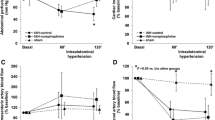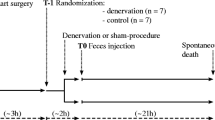Abstract
Pancreatic blood flow rates were determined using a133Xe washout technique in a total of 40 dogs, 14 of which were used as a control group and the remaining 26 as the experimental group. The initial pancreatic blood flow rates of control group and of the experimental group were 85.1±10.1 ml/100g/min of pancreas/min and 81.1±5.4 ml/100g/min respectively. These values were not significantly different from each other (P>0.05). In the control group the blood flow was determined 3 times at 30 min intervals. These mean values were 73.0±9.4, 74.6±8.7, and 79.4 ±10.4 ml/100g/min respectively (P>0.05). The dogs in the experimental group were bled and the peripheral arterial blood pressure was reduced stepwise to 80, 50, and 30 mm Hg. At each level a 30 min of stabilization period the pancreatic blood flow rates were 49.8±3.7, 29.3±2.3 and 20.2±2.3 ml/100g/min respectively. These mean values were very significantly reduced compared to those of the control group, at 30 min (P<0.02), at 60 and 90 min (P>0.001). They were also very significantly different from their own initial values (P<0.001). the metabolic consequences of this reduction in pancreatic blood flow are discussed.
Similar content being viewed by others
References
Aune S, Semb LS (1969) The effect of secretin and pancreozymin on pancreatic blood flow in the conscious and anesthetized dog. Acta Physiol Scand 76:406–414
Bor NM (1975) The net insulin secretion and pancreatic blood flow in hypovolemia and in shock. New Istanbul Contrib Clin Sci 11:70–74
Bor NM, Ercan M, Dinctürk C, Gemalmaz A, Öner G, Pamuk F, Bekdik C (1972) Sokta pankreas kan akminin karbonhidrat entoleransi ile iliskisi. Diabetes 4:39–55
Coddling JA, Rappaport AM, Ashworth MA, Kalnins A, Haist RE (1975) Effect of insulin output and pancreatic blood flow of glucagon, secretin, tolbutamide and thiocid infusions into an in situ isolated portion of pancreas. Horm Met Res 7:199–204
Conn HJ, Jr (1961) Equilibrium distribution of radioxenon in tissue: Xenon hemoglobin association curve. J Appl Physiol 16:1065–1070
Delaney JP, Grimm E (1964) Drug influences on pancreatic blood flow. Fed Proc 23:252–258
Delaney JP, Grimm E (1966) The influence of hormones and drugs on canine pancreatic blood flow. Am J Physiol 211:1399–1402
Dietzman RH, Block JH, Feemster JA, Idezuki Y, Lillehei RC (1967) Mechanisms in the production of shock. Surgery 62:645–654
Ercan MT, Bor NM, Bekdik CF, Öner G (1974) Measurement of pancreatic blood flow in dog by133Xe clearance technique. Pflügers Arch 348:51–57
Fisher U, Hommel H, Schmid E (1973) Continuous registration of pancreatic blood flow after intravenous application of glucose. Experientia 29:884–885
Fisher U, Hommel H, Salzsiuder E (1976) Pancreatic blood flow in conscious dogs after oral administration of glucose. Diabetologia 12:133–136
Forsyth RP, Hoffbrand BI, Melmon KL (1970) Redistribution of cardiac output during hemorrhage in the un-anaesthetized monkey. Circ Res 27:311–320
Glazier G, Needham T (1974)133Xe clearance for repeat assessment of pancreatic blood flow in the anesthetized dog. J Physiol 240:32P
Isbister WH, Schofield PF, Torrence HB (1965) Measurement of the solubility of Xenon-133 in blood and human brain. Phys Med Biol 10:243–250b
Kaihara S, Rutherford RB, Schwentker EP, Wagner HN (1969) Distribution of cardiac output in experimental hemorrhagic shock in dogs. J Appl Physiol 27:218–222
Kris AO, Miller RE, Wnerry FE, Mason JW (1966) Inhibition of insulin secretion by infused epinephrine in Rhesus Monkeys. Endocrinology 78:87–97
Kuznetsova EK (1963) Characteristics of blood supply of the pancreas during different phases of its activity. Fed Proc (Transl suppl) 22:99–104
Lau TS, Taubenfingel W, Levene R, Farago G (1972) Pancreatic blood flow and insulin output in severe hemorrhage. J Trauma 12:880–885
Lefer AM, Spath JA, Jr (1974) Pancreatic hypoperfusion and the production of a myocardial depressant factor in hemorrhagic shock. Ann Surg 179:868–876
Lenninger S (1973) Effects of acetylcholine and papaverine on the secretion and blood flow from the pancreas of the cat. Acta Physiol Scand 89:260–268
Manabe T, Suzuki T, Honjo I (1978) Role of the pancreas in organ blood flow during shock. Surg Gynecol Obstet 146:577–582
Mandelbaum I, Morgan CR (1969) Pancreatic blood flow and its relationship to insulin secretion during extracorporeal circulation. Ann Surg 170:753–758
Papp M, Varga B, Acz Zs, Krasnai I, Földes J (1966) Pharmacological effects on pancreatic blood flow. Arch Int Pharmacodyn Ther 161:61–68
Rappaport AM, Kawamura T, Davidson JK, Lin BJ, Ohira S, Zeigler M, Coddling JA, Henderson J, Haist RE (1971) Effects of hormones and of blood flow on insulin output of isolated pancreas in situ. Am J Physiol 221:343–348
Roding B, Schenk WG, Jr (1970) Mesenteric blood flow after hemorrhage in anesthetized and unanesthetized dogs. Surgery 68:857–861
Sapirstein LA, Buckley NM, Ogden E (1955) Splanchnic blood flow after hemorrhage. Science 122:1138
Sapirstein LA, Sapirstein EH, Bredemeyer A (1960) Effect of hemorrhage on the cardiac output and its distribution in the rat. Circ Res 8:135–148
Semb LS, Aune S (1971) The effect of glucose and insulin on pancreatic blood flow in the anesthetized pig. Scand J Clin Lab Invest 27:105–111
Suzuki T, Matsuoka K, Imamura M, Ohara H, Honjo I (1974) Measurement of pancreatic blood flow with133Xe clearance method in dogs. Proc Ist World Cong Nucl Med. Tokyo, pp 525–527
Wright CJ (1974) Blood flow and oxygen consumption during severe progressive hemodilution. Surg Forum 25:198–199
Author information
Authors and Affiliations
Additional information
This study was supported in part by grants No. 264 and 315 of Turkish Scientific and Technical Research Council
Rights and permissions
About this article
Cite this article
Bor, N.M., Alvur, M., Ercan, M.T. et al. Pancreatic blood flow in hemorrhagic shock. Pflugers Arch. 386, 277–280 (1980). https://doi.org/10.1007/BF00587479
Received:
Accepted:
Issue Date:
DOI: https://doi.org/10.1007/BF00587479




